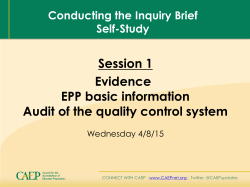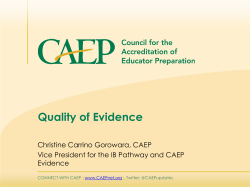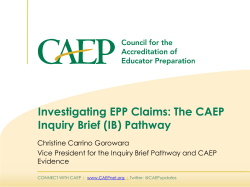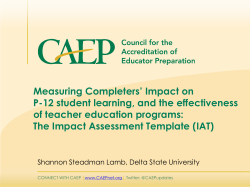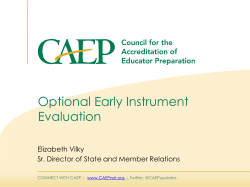
Partnerships for Practice: CAEP Standard 2 (CAEP 101)
Partnerships for Practice: CAEP Standard 2 (CAEP 101) Elizabeth Vilky Sr. Director of State and Member Relations Elizabeth.vilky@caepnet.org CONNECT WITH CAEP | www.CAEPnet.org | Twitter: @CAEPupdates Rationale • Collaborative partnerships are a shared endeavor meant to focus on the improvement of student learning and development and on the preparation of teachers for this goal. • Partners work together to determine not only the values and expectations of program development, implementation, assessment, and continuous improvement, but also the division of responsibilities among the various partnership stakeholders. CONNECT WITH CAEP | www.CAEPnet.org | Twitter: @CAEPupdates Standard 2: Clinical Partnerships and Practice • The provider ensures that effective partnerships and high-quality clinical practice are central to preparation so that candidates develop the knowledge, skills, and professional dispositions necessary to demonstrate positive impact on all P-12 students’ learning and development. CONNECT WITH CAEP | www.CAEPnet.org | Twitter: @CAEPupdates Standard 2, component 2.1 – Effective Partnerships & High Quality Clinical Practice • 2.1 Partners co-construct mutually beneficial P-12 school and community arrangements, including technology-based collaborations, for clinical preparation and share responsibility for continuous improvement of candidate preparation. CONNECT WITH CAEP | www.CAEPnet.org | Twitter: @CAEPupdates Possible Types of Evidence • Description of partnerships (e.g., MOU) Evidence that partners collaborate on clinical decisions Opportunities are available for input from partners on such things as clinical practice procedures and policies, assessments, placements, focused teaching opportunities, and other clinical based experiences CONNECT WITH CAEP | www.CAEPnet.org | Twitter: @CAEPupdates Standard 2, component 2.1 – Effective Partnerships & High Quality Clinical Practice • Possible Types of Evidence Common expectations have been set for candidates Shared responsibility for continuous improvement of preparation program Orientation of clinical educators Field experience handbooks (section(s) specific to component Documentation of stakeholder involvement Candidates participation in professional development through the clinical site Retention of clinical educators CONNECT WITH CAEP | www.CAEPnet.org | Twitter: @CAEPupdates Standard 2, component 2.1 – Effective Partnerships & High Quality Clinical Practice • They [partners] establish mutually agreeable expectations for candidate entry, preparation, and exit; ensure that theory and practice are linked; maintain coherence across clinical and academic components of preparation; and share accountability for candidate outcomes. • Possible Types of Evidence Process described on how partners are part of the creation of candidate entry, preparation, and exit requirements – How are partners included in the discussions? CONNECT WITH CAEP | www.CAEPnet.org | Twitter: @CAEPupdates Standard 2, component 2.1 – Effective Partnerships & High Quality Clinical Practice • Possible Types of Evidence Partners are included in discussions and their input is sought on such things as focused teaching experiences, course content, and key assignments. Partner’s opinions are sought on incorporating a new theory or approach before it is implemented in a clinical experience. Partner’s and EPP share the accountability for candidate’s impact on student learning during the clinical experience. • Evidence in self-study could be a simple description of what is done – verification happens on site CONNECT WITH CAEP | www.CAEPnet.org | Twitter: @CAEPupdates Thinking about 2.1: Partners co-construct mutually beneficial P-12 school and community arrangements (example) • No specific benefits are identified for the K-12 schools or the EPP. • No evidence demonstrating a collaborative process • Evidence is one directional Does not meet minimum criteria • Placements are guided by EPP or K-12 school • Evidence (MOU, minutes, agendas, community based projects, etc) shows that a collaborative process is in place • Evidence shows that the K-12 schools and the EPP have Meets minimum benefited from the partnership criteria CONNECT WITH CAEP | www.CAEPnet.org | Twitter: @CAEPupdates Standard 2, component 2.2 – Effective Partnerships & High Quality Clinical Practice • 2.2 Partners co-select, prepare, evaluate, support, and retain high-quality clinical educators, both provider- and school-based, who demonstrate a positive impact on candidates’ development and P12 student learning and development. Possible sources of evidence • Clinical educator and clinical placement characterized by co-selection and based on shared criteria • Criteria for selection of clinical educators • Professional dispositions evaluation • Surveys of clinical educators, candidates, employers, and/or human resources CONNECT WITH CAEP | www.CAEPnet.org | Twitter: @CAEPupdates Standard 2, component 2.2 – Effective Partnerships & High Quality Clinical Practice Possible Sources of Evidence • • • • Performance evaluations (clinical observation instrument) Records of counseling out of clinical educators Clinical educators training/coaching Joint shared curriculum development/design/redesign CONNECT WITH CAEP | www.CAEPnet.org | Twitter: @CAEPupdates Thinking about 2.2 Partners co-select, prepare, evaluate, support, and retain high-quality clinical educators (example) • Mentor teachers are assigned by a central office and evaluated by university supervisors and candidates only. Does not meet minimum criteria • EPP and P-12 educators and/or administrators are involved in the selection of clinical educators. • Clinical educators evaluate each other and are evaluated by candidates. Meets minimum • Results are shared with clinical educators and university supervisors. criteria CONNECT WITH CAEP | www.CAEPnet.org | Twitter: @CAEPupdates Standard 2, component 2.3 – Effective Partnerships & High Quality Clinical Practice • The provider works with partners to design clinical experiences of sufficient depth, breadth, diversity, coherence, and duration to ensure that candidates demonstrate their developing effectiveness and positive impact on all students learning and development. Clinical experiences, including technology enhanced learning opportunities, are structured to have multiple performance based assessments at key points within the program to demonstrate candidates’ development of the knowledge, skills, and professional dispositions, as delineated in Standard 1, that are associated with a positive impact on the learning and development of all P12 students. CONNECT WITH CAEP | www.CAEPnet.org | Twitter: @CAEPupdates Standard 2, component 2.3 – Effective Partnerships & High Quality Clinical Practice • Possible Sources of Evidence Evidence that clinical experiences have “sufficient depth, breath, diversity, coherence, and duration.” • Description of clinical experience goals and operational design • Documentation that clinical experiences are implemented as described (could be part of 3rd party survey) • Scope and sequence matrix is provided that charts depth, breath, and diversity of clinical experience • Chart of candidates’ experienced in diversity settings CONNECT WITH CAEP | www.CAEPnet.org | Twitter: @CAEPupdates Thinking about 2.3: The provider works with partners to design clinical experiences of sufficient depth, breadth, diversity, coherence, and duration (example) • Mentor teachers are assigned by a central office and evaluated by university supervisors and candidates only. Does not meet minimum criteria • EPP and P-12 educators and/or administrators are involved in the selection of clinical educators. • Clinical educators evaluate each other and are evaluated by candidates. Meets minimum • Results are shared with clinical educators and university supervisors. criteria CONNECT WITH CAEP | www.CAEPnet.org | Twitter: @CAEPupdates Contact Information Elizabeth Vilky, Senior Director of State and Member Relations elizabeth.vilky@caepnet.org Stevie Chepko, Senior Vice President, Accreditation stevie.chepko@caepnet.org CONNECT WITH CAEP | www.CAEPnet.org | Twitter: @CAEPupdates QUESTIONS CONNECT WITH CAEP | www.CAEPnet.org | Twitter: @CAEPupdates
© Copyright 2025
